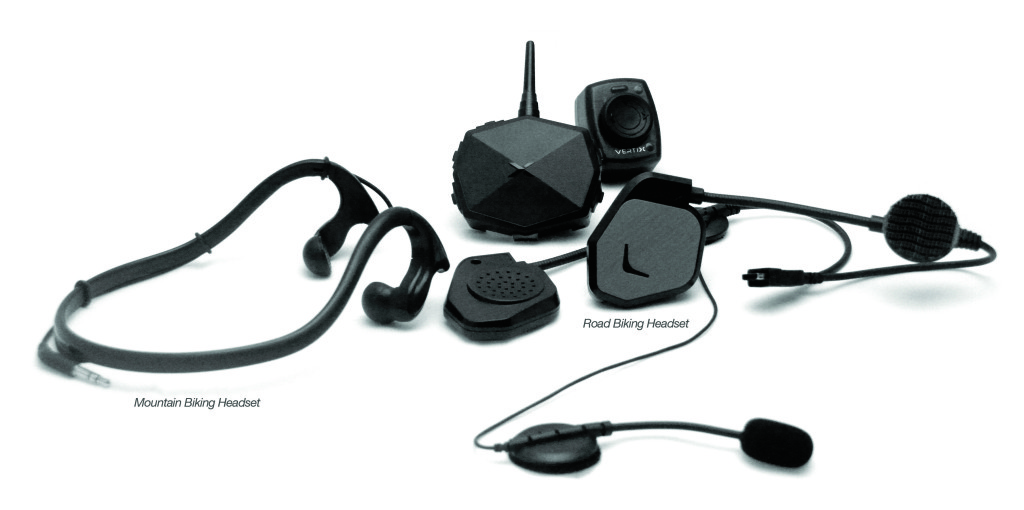From time to time I get to review something really new and I get pretty excited about these things! So therefore I have been looking forward to publishing my Vertix Velo review for a little while now and I am really now pleased to do this. A number of my friends know that this has been in the pipeline and have been curious about this new gadget. So here goes….
The Vertix Velo is an intercom device for cyclists. It allows a pair of cyclists to be in clear communication with each other while riding along. Add one or two extra headsets and you have a maximum of four cyclists in touch with each other. There are quite a few uses for this, which I will outline below but for now I will go through the description followed by my impressions.
Description
There are two versions: the road and mountain. Both share the same technology and base unit, which is called the velo. The velo fixes to the back of a helmet and the ear pieces are either the in-ear design for the mountain version, or on the road version there are some small speakers which fit near the ears. Here I review the road version as that is the sample I received but I imagine the mountain version will perform exactly the same.
For you techie peeps, it works using Bluetooth technology (version 3.0 Class1). The frequency band is 2.4 – 2.4835GHz and the range between two devices is up to 500 metres (up to 1km with 4 devices) and they need to be in the line of sight of each other. The profiles supported are HPF, AVRC, A2DP, SPP. The batteries last 10 hours between charges.
There is also a handlebar remote control unit which uses a CR2032 battery and is used for connecting or disconnecting to another velo unit. The Velo is described as being suitable for all weather use. The weight of the velo is 100g.
It is also possible to link the Velo to a smart phone, either for listening to music (not sure I recommend this) or for using the telephone. The Velo automatically answers the call after a few rings.
Getting ready for using the headsets
Installing the headset onto a helmet was straightforward and fairly easy, it is worth taking time to get everything exactly right. The instructions at this point are pretty good and there are a number of self adhesive velcro pads for holding things in the right place, for example the speakers, microphone and cables. Strapping the velo unit at the back of the helmet was easy using the black web straps and helpfully there are some pads to stop any vibration and ensure a good, snug fit. Once you’ve got it in the right place there’s no way it will fall off or move around; and it seems to blend in to the look of the helmet. Also worth bearing in mind that some cyclists (myself included) may have a light on the back of the helmet which might need to be repositioned.
Fixing the speakers in place using the supplied velcro pads was also straightforward and there was no problem running the cables along the inside of the helmet. These velro pads are extremely secure and there are a few spares, which is useful.
To get the microphone in the right place, you have to make sure your helmet fits correctly in the first place (I see loads of cyclists with loose straps which flap around and are simply in the wrong place). So once your helmet fits you and the strap running under your chin is correct, that’s the time to fix the velcro pad in place. For myself I found the buckle was a perfect place and then the positioning of he microphone can be fine tuned by bending the connecting piece into the right place. Simple!
Charging the velo units for the first time was simple enough and there are some LED lights to reassure you this is happening. A charging lead is supplied. It took a few hours, as per the instructions. I should say at this point, it was reassuring to hear a programmed voice telling me the battery was fully charged. The remote control runs from a CR2032 battery, which was not supplied in my sample and so you may need to buy your own.
As a one-off step you need to pair the two (or more) headsets with each other, also you need to pair the remote control with its own headset. As I am not a very techie person, as most of my family and friends will testify, I needed some help. It took a while to get them working alright but once it was done all was fine. I think the instructions are fine for someone who is naturally good at these things but could be improved for people like me, or perhaps to increase the information available on the website. The use of the remote control could need some further information.
In use
We first used the headsets in the house and they seemed loud and clear but we were keen to use them on the road. I was actually really surprised at how good and clear the sound was. There are a couple of things you need to do:
- Make sure the microphone is positioned close to your mouth
- Talk normally, don’t shout
- Take time to experiment with the positioning of the speakers, the ear pieces. I think that getting the positioning right is easy so you can still hear the traffic around you as this is an important safety consideration. The flexible arms make this very easy and they are sufficiently stiff to stay in position. I did find at first they “whistled” but this was solved by simply changing their position slightly.
- Learning to cycle on the roads – for children and adults alike. Someone very near and dear to me has needed some coaching on the best way around roundabouts and this could be a great solution by either standing on the pavement and talking the nervous cyclist, or riding behind and giving instructions. Trying to talk to someone in busy traffic by yelling out is not easy and the Vertix provides an easy solution.
- For cycling clubs and teams, a coach could find this useful in giving guidance, instructions etc such as changing gear, positioning on the road or in a peloton as well as some motivational talk (“pull your finger out and get a move on” and other less polite versions)
- The Mountain version would benefit those who might want to talk through avoiding obstacles or giving instructions about which way to go
- This could be a great solution for maintaining harmony between family and friends with “would you pleeeeease slow down” and other polite requests about not leaving me behind in a sweaty, gasping-for-breath heap
- Excellent sound quality, much better than I expected
- Secure fitting to helmet
- Not too heavy or cumbersome
- I like the easy way you can adjust the ‘arms’ to get the speakers in the right position
- The speakers do not interfere with hearing the sound of traffic around you, helpful for safety on the road
- Good battery life
- Operating instructions
- The LEDs are sometimes difficult to see in bright sunlight
Summing up
I really enjoyed testing these out and I’m very grateful to Joxlyn Tay in Vertix for asking me to carry out this review.
I think Vertix have done well with the Velo in terms of the design and the excellent sound quality, battery life and while I have pointed out a couple of areas for development, these are relatively minor and easy to resolve. These are relatively new on the cycling market which will undoubtedly develop soon. There are clearly a number of markets for an innovative product like the Vertix Velo ranging from beginners through to competitors and it will be interesting to see how the market develops.
For further details, go to the Vertix web page






 RSS – Posts
RSS – Posts
An interesting innovation. Is there any way to wear the headsets on their own, rather than in a helmet?
Hi Adam,
They’re really designed for a helmet. I think it might be possible to fit them onto a hat but the problem might be knowing where to fit the microphone. You’re welcome to take a closer look, just let me know.
Hi Adam & Doug,
good news is that we are currently developing the product to be used without helmets! Watch out for our updates 🙂